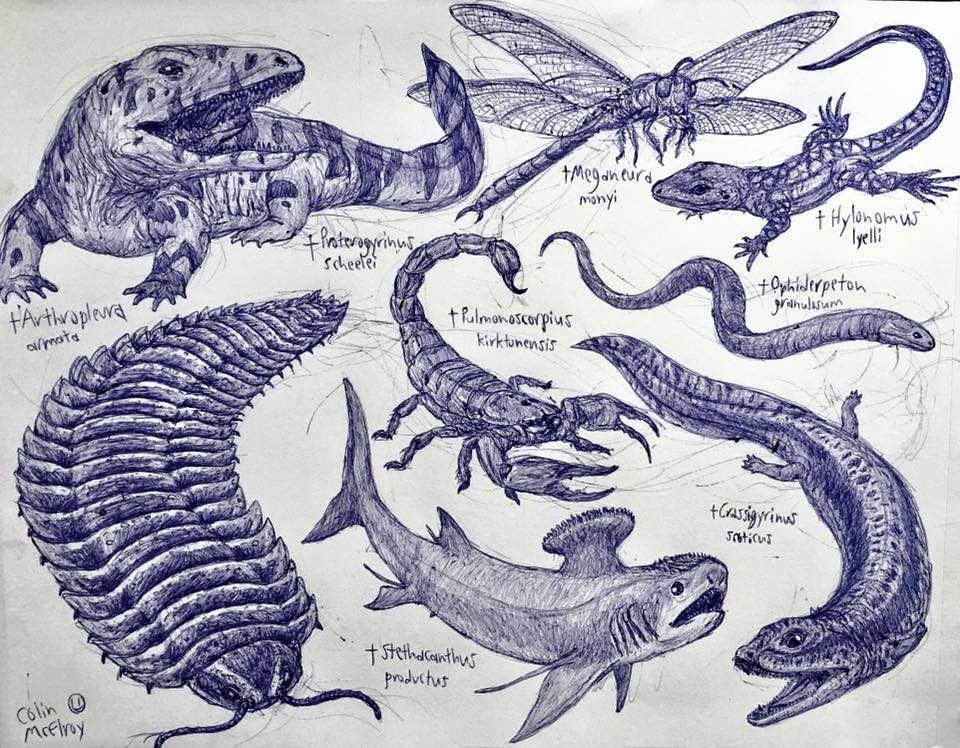Deviation Actions
Description
The Carboniferous period, between the Devonian and Permian periods, lasted from about 360 to 298 million years ago. During this period oxygen levels in Earth's atmosphere were higher than a any other time in history; as high as 35%. This was likely due to the growth of vast swamp forests across much of the planet. These forests are often called the coal forests, because it was the decomposition of these forests and the accumulation of peat that created much of the coal found across Europe and America today. Plants grow to fantastic sizes, but most of them were unfamiliar to us, including giant horestails, seed-ferns, club mosses, and true tree-ferns. The earliest conifers and cycads appeared as well, but were not as widespread as other plants. The oceans, as well as lakes, streams and swamps, were filled with sharks, early ray-finned fish, giant lobe-finned fish, and sea scorpions. Arthropods became most prevalent on land, and several species from many different arthropod groups became enormous compared to living arthropods. These included dragonfly-like insects as big as hawks and millipedes as long as cars. It's likely this gigantism in arthropods was due to the high levels of oxygen in the air, which allowed arthropods to use less effort to breath through spiracles in their skin, allowing them to grow much larger than they could today. The lack of large vertebrates on land also help give the arthropods a head start at exploiting many niches, including the first large herbivores.
Amphibians thrived in the warm moist climate as the insects and millipedes did. With their thin skin and soft-eggs, they were still water-bound, but they had grown in diversity and size with some species growing 15 feet long. Some were still mostly or totally aquatic, while others could spend most of their time on land. During the later half of the period some amphibians evolved thicker skin with scales to protect them from drying out, allowing them to be more independent from the water. Around 312 mya, these amphibians gave rise to a whole new class of animals with the evolution of one incredible adaptation; the first reptiles and the amniotic egg. The amniotic egg contained the embryo in a moist environment with waste and nutrient exchange systems inside a hard shell. This meant the animals would no longer have to return to the water to reproduce and could breed and live completely on land. By the end of the Carboniferous the early reptiles had spread throughout the world.
The late Carboniferous saw an increase in glaciation and a drop in sea levels. This changed the global climate from hot and humid to cool and dry. The great coal forests began to shrink into isolated pockets until by the mid-Permian they had all but disappeared. With them most of the supersized arthropods were lost as well, along with many kinds of amphibian. The reptiles on the other hand took the new dryer climate in their stride, and by the Carboniferous-Permian boundary had started to grow to great sizes.
†Proterogyrinus scheelei: a giant amphibian from Scotland of 331-323 mya, Proterogyrinus grew up to eight feet long. With powerful jaws, strong limbs and a finned tail it was an apex predator of both water and land.
†Arthropleura armata: this species of millipede was the largest invertebrate to ever live on land, growing over eight feet long. With its massive size and thick plates covering its body, Arthropleura probably had no predators to threaten it. Arthropleura itself was a peaceful herbivore, the first large herbivore to exist on land.
†Stethacanthus productus: this bizarre shark which lived from the Devonian to the Carboniferous, lived in both salt and freshwater. Sharks became more dominant predators after the extinction of the giant placoderms at the end of the Devonian. Stethacanthus sported an unusual dorsal fin shaped like an anvil with a patch of short brush-like spines on top. Another patch of spines sat on top of the sharks head. It is not known what the strange fin and spines were used for, but they likely made the shark a comparatively slow swimmer.
†Pulmonoscropius kirktonensis: this scorpion from Scotland grew to over two feet long and was as big as a cat. With its long pincers and massive stinger it probably preyed upon smaller arthropods and perhaps small tetrapods.
†Meganeura monyi: this massive insect was a cousin of modern dragonflies and looked very similar. With a wingspan of over two feet this was the largest flying insect of all time(except for a relative that survived into the early Permian). Like dragonflies Meganeura had massive eyes to help it spot prey from above.
†Hylonomus lyelli: this lizard-like animal lived 312 mya in Canada. Around 8 inches long Hylonomus is considered the earliest known reptile(other older species exist but whether they were true reptiles is not certain). From Hylonomus and its relatives would spawn an incredible dynasty of land vertebrates from lizards and snakes to crocodiles, pterosaurs, dinosaurs and birds.
†Ophiderpeton granulosum: this three foot long amphibian had no limbs. It resembled a snake but was not a reptile, and it resembled the modern limbless amphibian caecilians but was not closely related to them either. It likely spent most of its time in the water feeding on worms and insects.
†Crassigyrinus scoticus: Crassigyrinus was six foot long amphibian with a short but massive set of jaws complete with two rows of teeth, the second row with a pair of long fangs. Large eyes suggest it was either nocturnal or lived in very murky water. Its limbs were very short, the forelimbs little more than stubs, so it was likely Crassigyrinus never left the water. With its long body and finend tail it would have been a powerful swimmer.
Epic but I would love to see hibbertopterus and platyhystrix to.




































